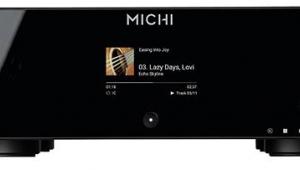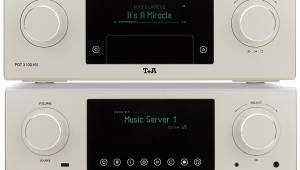Accuphase Dp 510 (£6000)

Classical in its simplicity, the layout of the front-panel places the usual Play, Pause, Back, Next and Stop controls to the right, visually balancing the big power on/off switch to the left. In the centre, large flanking buttons extend the visual line of the loading drawer to match the width of the display above. The drawer emerges smoothly, quickly and almost silently. The button marked ‘CD/Proc’ switches between normal CD replay and ‘processor’ mode, in which the DAC accepts digital inputs from external sources.
More facilities are available on the RC-100 remote handset, eg, numeric keys for direct track entry, Fast Forward and Reverse for searching within a track, Repeat and Program Play, and Time, to switch the display from elapsed to remaining track time, or total remaining time. There is no control for display brightness.
Unusually, however, there are keys to search for index points on a CD. Finally, a digital level control gives 0 to –60dB attenuation of the analogue output for system matching. This is not meant to be used as a volume control and is normally best left in the maximum 0dB position.
Rear panel analogue output is available via phonos or balanced, via XLRs and a phase switch caters for reversed XLR polarity. There are digital outputs from the transport as well as digital inputs to the processor section, with coaxial and optical options for both. Surprisingly, perhaps, the Accuphase DP-510 does not provide a USB digital input.
Smoothness
Starting with Marta Gomez’s Entre Cada Palabra [Chesky JD301], we were intrigued to see how the Accuphase would deliver the spatial effects of Chesky’s church recording venue. To be picky, although the Accuphase did deliver the spatial clues that tell you how big – and particularly how deep – the recorded acoustic is, we felt that the sense of space was something you had to listen for, rather than being presented effortlessly. Yet the Accuphase delivered a smooth and entirely engaging sound.
And with Dylan’s Blood On The Tracks [Columbia], the player really did present a huge, convincing soundstage, with a solid, tactile quality that gave force to the songs. In ‘Simple Twist Of Fate’ the timbre of the acoustic guitar was ear-catching, and Dylan’s go-for-broke vocal filled the centre of the stage with maximum expression.
Moving on to Florence And The Machine with Lungs [Island/Moshi Moshi], the DP-510 was impressively clear and detailed. On the opening of ‘Dog Days Are Over’ the synthed handclaps sounded really crisp, with a great sense of presence to Florence’s vocal. ‘Rabbit Heart’ revealed the player’s ability to reproduce deep and clean bass too.
Turning to orchestral music, we found Respighi’s Church Windows [Reference Recordings] somehow seemed to suit the DP-510 down to the ground, as ‘The Flight Into Egypt’ steadily unfolded with a kind of stately mystery. There was a fine natural quality to the strings, and a good feeling of space, underpinned by a deep but unexaggerated bass.
Mitsuko Uchida and Debussy’s Twelve Etudes [Philips] can be a challenging CD, as the bright sound of the piano audibly ricochets around the reverberant Snape Maltings acoustic, but here the
DP-510 easily negotiated this music’s extreme contrasts.
Verdict
This heavyweight player offers superb engineering and build quality. It sounds excellent, its great virtues being smoothness, balance and consistent listenability. It sets a standard that’s hard to fault.
Originally published in the 2013 Yearbook



























































